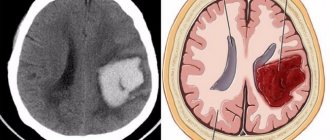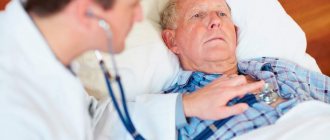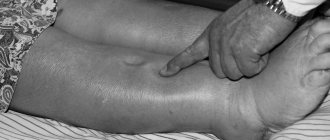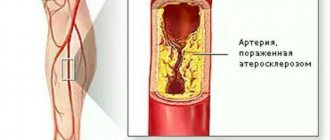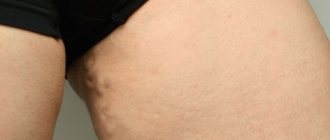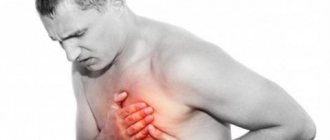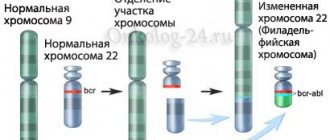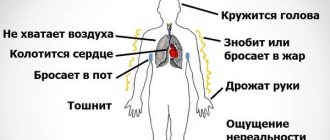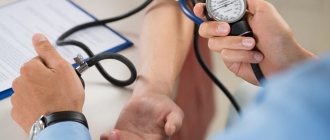Victoria Popova
Cardiologist
Higher education:
Cardiologist
Saratov State Medical University named after. IN AND. Razumovsky (SSMU, media) Level of education - Specialist 1990-1996
Additional education:
“Emergency Cardiology”
1990 - Ryazan Medical Institute named after Academician I.P. Pavlova
Contacts
Precursors of cerebrovascular accident
What are they, the very first signs of stroke in women. Yes, you can’t even pay attention to them. The book fell out of her hands, she stumbled out of the blue, she said an incoherent phrase - but it will quickly pass and will only cause a smile, without making you think about the reason.
If I forgot to fulfill your request, that’s also okay. An elderly woman and forgetfulness are not at all surprising. Hypertensive patients may feel dizzy and have noise in their heads - and this is common and does not clearly indicate signs of a stroke in a woman. But if incoherent speech continues, limbs become numb, unsteadiness appears in the gait, be wary here. Ask to smile and stick out your tongue - only one half of the face will react in a sick person, and the tongue will deviate to the right or left. And these will no longer be harbingers of a stroke, but the most undeniable symptoms of a stroke in women.
Pre-stroke, manifestation in old age
This is not to say that in older women, the symptoms of a rapidly impending stroke do not resemble strokes in women of other age groups. And, nevertheless, a severe headache that came on suddenly and even swayed the woman immediately makes her wary. They also more often experience diplopia (double vision) and even complete blindness. Vomiting accompanies unilateral headache. Weakness and numbness in the limbs, more on one side. Hyperemia of a distorted face and fainting. When eating, liquid food leaks from the mouth. Dyspnea.
What to do?
The main thing is to quickly call an ambulance. Before the team arrives, first aid consists of putting the patient to bed. Position on your back with your head elevated on the pillow, approximately thirty degrees. Be calm. Remove excess tight clothing and remove dentures, if present. When vomiting occurs, carefully turn your head to the side so that the patient does not choke. Apply a cold towel to your head. If you have restless behavior or convulsive syndrome, beware of falling on the floor. Do not give antihypertensive drugs, even if the blood pressure is elevated - without knowing the nature of the stroke, you can cause dislocation (displacement) of the brain and cause respiratory and cardiac arrest. Remember, the consequences of a stroke in women can be sad, so don’t fuss, don’t try to do too much, which will complicate further actions of doctors.
Diagnostics
At the initial stage of diagnosis, the doctor will ask about the patient’s feelings and clarify the medical history. A typical sign of a mini-stroke is a painful headache - it does not disappear even after taking medications. The symptom is intensified by such unpleasant symptoms as dizziness and nausea. In this state, women cannot do their work; they constantly want to lie down to rest. As the pain worsens, the heart rate may increase and cardiac colic may appear.
With a microstroke, the first signs of pathology can be confused with fatigue, but later the symptoms of the pathology worsen. Pathology can be recognized by poor coordination of movements, falling, decreased sensitivity to light stimuli, or vice versa – excessive excitability. As the pathology progresses, the limbs become numb, and the memory and speech apparatus suffer significantly. A characteristic facial expression appears with a skew to one side. Nausea and vomiting may occur.
If, during diagnosis, the doctor promptly identifies the signs of pathology and makes the correct diagnosis, then the consequences of a stroke will become less aggressive.
Minor disturbances in brain function during a stroke can be restored in the simplest way - rest, get enough sleep and eat plenty of vitamins. The doctor will prescribe a number of medications that will relieve tension in the pathological area. The most important information that patients should understand is that an untreated heart attack leads to the appearance of various complications in the future. Dealing with them will not be so easy.
Stroke at a young age
If, according to statistics, in middle and older age, stroke more often strikes men, then the impending stroke in young women corrects this statistics - young women suffer from stroke more often than men.
Causes:
- Childbirth
- Pathology of pregnancy and childbirth
- Contraceptives in pills increase the risk many times over as they lead to blood thickening
- Congenital or rheumatic heart defects
There are explanations for this. Since pregnant women have impaired blood rheology (fluidity) as a result of increased clotting, the risk of blood clots increases, especially in the third trimester. The detachment of a blood clot and migration to the brain leads to a stroke. Less often, but the same ending awaits a woman with eclampsia.
From the above, it is clear that the symptoms of stroke in women are different and numerous, as are the risks of developing the disease.
Danger of pathology
Sometimes during magnetic resonance therapy it can be determined that the patient has already suffered an illness related to the brain, which went unnoticed. This is life-threatening. A micro-stroke, the consequences of which can be even worse, must be treated comprehensively. Only a specialist in this field can determine the presence of pathology after appropriate diagnosis.
In order to find out whether a person has a chance of contracting this disease, you need to analyze the list of risk groups and compare it with your possible pathologies and changes in the body.
Hospital treatment
There will be no favorable prognosis for resolution of the disease without competent basic therapy for stroke. And female stroke is no exception. When hospitalized in the intensive care unit, monitoring of all body systems is mandatory.
If breathing is inadequate, the patient is connected to a ventilator. During this period, feeding is carried out through a tube and intravenous drip administration of a concentrated solution of glucose and nutrient media to eliminate and replenish the body's energy costs. Control of stool and urination is mandatory. Patients in serious condition are turned on their sides every two hours to prevent bedsores. Treat the oral cavity, nose and skin with antiseptic liquids.
Drug therapy is aimed at relieving cerebral edema, normalizing cerebral blood flow, improving the metabolism of nerve cells, and correcting blood pressure. From the very first day, preparation for the rehabilitation of the patient begins - physical therapy consists of passive flexion and extension of the fingers and joints of the limbs. A massage is required, which will continue at home. Therefore, the patient’s relatives must learn basic techniques.
With the same success, they will master a set of physical therapy exercises, which the instructor will create based on the patient’s condition. All movements should be performed smoothly, without excessive zeal. The approaching day of discharge should encourage relatives to carefully master exercise therapy.
Micro-stroke, symptoms, first signs in women
“Micro-stroke, symptoms, first signs in women” - this is the topic of our article today.
Minor stroke, transient ischemic attack (TIA) , transient cerebrovascular accident are different names for the same vascular process - microstroke.
A microstroke is a local lesion of the blood vessels of the brain , has a number of similar symptoms to a large stroke, but its manifestations are not so pronounced, and the attack is characterized by “transience”, lasting from several minutes to a day.
Men and women can be equally exposed to transient ischemic attack , but due to the natural differences between male and female bodies, the course of the process will differ in the clinic.
Differences between a microstroke and a stroke
A microstroke is a transient circulatory disorder in the cerebral vessels . It occurs against the background of constantly elevated blood pressure, its sharp rise, or atherosclerosis, when cholesterol plaques are deposited on the inner walls of blood vessels.
Important! Regularly measure your blood pressure with a tonometer, if you don’t have a tonometer, be sure to buy one, it’s not expensive, but every family should have it, here (on Aliexpress) you can always choose an inexpensive option.
The mechanisms of development of TIA and stroke are the same, they are similar in manifestations and symptoms:
- Bursting pain appears in the back of the head.
- You can clearly feel the blood pulsating in your temples.
- The sense of orientation disappears even in a familiar, familiar space.
- Limbs become numb and swollen. Swelling begins in the toes and feet, then swells in the fingers and forearms.
- Hyperhidrosis begins - increased sweat production throughout the body.
- The heart rhythm is lost.
- Both with a micro-stroke and with a large stroke, dizziness, fainting, and loss of consciousness are noted.
- In both the first and second cases, a change in vision is noted: “spots” or colored spots or circles appear before the eyes. At the very beginning of attacks, objects may look unnatural
- bright and clear, after a few minutes the colors fade, the surroundings are seen as if through a veil or fog.
- Loud sounds and bright colors begin to irritate.
- Paresis develops.
- Dysphagia develops - a violation of the swallowing reflex.
- Facial facial muscles are affected. And as a result, facial distortion occurs. A crooked, lopsided smile appears on the face, and the corners of the mouth droop.
Both during a stroke and during a transient ischemic attack, the whites of the eyes may turn red. In both cases, confusion and speech disturbances may occur, when it becomes slurred and difficult to understand.
Which pills are best for lowering blood pressure? Secrets of doctors!
With all this, the processes differ in clinical picture:
- The symptoms of a microstroke are less pronounced.
- All manifestations of TIA disappear in a short period of time, the maximum duration of an attack is 24 hours, but usually it lasts no more than a few minutes.
- With a microstroke, a rapid heartbeat is observed, the skin of the face turns red; With a major stroke, the heart rate slows and the face turns pale. Facial pallor during a stroke is an alarming sign indicating a serious condition of the patient.
- With a microstroke, paresis develops - partial loss of motor activity; with a stroke, complete paralysis of the upper or lower extremities is possible.
- With a major stroke, large vessels supplying a given area of the brain are blocked or ruptured and, as a result, necrosis of the affected area and death of its nerve cells occurs. With a microstroke, small vessels are affected - capillaries and arterioles, the recovery of which occurs faster.
- In case of a microstroke, examination for the Babinski reflex will always give a negative result.
- With TIA, there is no enuresis; with a stroke, urinary incontinence is one of the constant symptoms.
- With a microstroke, gaze paresis does not develop, when friendly eye movement becomes impossible.
- With a microstroke, the pupils are the same size. With a stroke, anisocoria develops when one pupil is enlarged and the second is reduced in size.
This is the danger of a micro-stroke - in most cases it is endured “on your feet” , once, twice, three times, until an acute vascular catastrophe occurs, a major stroke. In case of a stroke, doctors have negligible time left to save the patient - only four and a half hours.
Distinctive features of female and male microstroke
Despite the similarity of symptoms and clinical picture, there are a number of specific differences between a “female” microstroke and a “male” one :
| Microstroke in women | Microstroke in men |
| The changes affect the vessels located in the occipital part of the head. This disrupts blood flow to the occipital and temporal lobes, cerebellum, and brain stem. | The vessels located in the front of the head are affected |
| Emotions are not controlled; the transition from tears to aggression can take several minutes. Mental disorders are one of the signs of a “female” microstroke | Changes in mental state occur rarely; a man is able to control his psycho-emotional state. |
| The risk of developing cerebrovascular accident is higher if a woman: has had an abortion or miscarriage; had complications during pregnancy | The risk of developing TIA in men has nothing to do with reproductive function |
| The recovery period takes longer, there is a high risk of relapse with more severe symptoms | Recovery is faster, consequences are less obvious |
Early subtle signs of microstroke in women
Early neurological symptoms depend on which part of the brain is affected by the ischemic attack.
So, if the blood vessels of the parietal lobe are affected, there is a decrease or complete loss of tactile sensitivity . It is impossible to determine the characteristics of an object with closed eyes, it is impossible to determine whether it is cold or warm, what kind of surface it has, smooth or rough; What shape is it - square, round, triangular.
When the occipital lobe is damaged, ophthalmological problems : vision decreases, it is impossible to visually identify even well-known objects.
The manifestations of a microstroke are surprising when the temporal lobe is affected. There are lapses in memory and a feeling of “déjà vu” - “recognition of the past,” a mental state when a person “remembers” a place, situation or event.
Intercostal neuralgia symptoms and treatment
The following are considered as common and earliest manifestations of microstroke in women:
- Semi-fainting conditions, accompanied by constant dizziness and severe headaches.
- Nausea, retching, or vomiting directly.
- Redness of the face and whites of the eyes.
- Characteristic tingling in the limbs.
Noticeable signs of the disease
As the process develops, the symptoms and first signs of a microstroke in women become brighter. This is exactly the moment when a microstroke can be differentiated from other diseases:
- Facial expressions are disrupted. When trying to smile, one corner of the mouth remains motionless, the smile turns out to be “crooked.”
- The sense of orientation in space disappears.
- Memory lapses begin.
- Numbness in fingers or toes.
- Vision is partially lost. An object or image is not completely visually perceived; only its right or left side is visible. With a microstroke, one of the symptoms is photopsia. a phenomenon where “floaters”, colored spots, zigzags or circles appear before the eyes.
- Muscle tone sharply decreases, the body is subjected to a drop attack, when a person suddenly loses consciousness for no apparent reason.
- In some cases, Wallenberg-Zakharchenko syndrome is observed - loss of coordination on one side of the body, unsteadiness of gait, dragging of the legs, inability to maintain balance.
Symptoms and warning signs that should prompt you to see a doctor
Symptoms of microstroke in women quickly disappear; often the disease can be diagnosed only in a medical institution.
There are several “ifs”, the combination of which makes it necessary to see a doctor:
- If severe and persistent headaches begin.
- If you see black or colored circles, spots, lightning before your eyes.
- If your heart rate and pulse rate are abnormal.
- If the limbs lose sensation.
- If control over facial expressions is lost.
- If one eye is in normal condition, and the other is half-closed.
- If speech is impaired and it is impossible to pronounce a logically completed phrase.
- If coordination is impaired and movements become uncoordinated.
What happens if you ignore a microstroke?
Statistics say that in ten out of a thousand people, TIA leads to the development of a stroke within the next three months.
Five out of a thousand people are admitted to hospital during the course of a year with a diagnosed ischemic stroke.
Ten to twelve people out of a thousand will be struck within five years after the first micro-stroke.
Providing first aid for a microstroke
If it is impossible to quickly call a doctor, follow this algorithm:
- The patient is placed in bed, providing unhindered access to fresh air.
- They give you a tablet of Aspirin, Agrenox or, if they are intolerant, Clopidogrel.
- To improve blood flow and protect brain neurons, give piracetam or Vinpocetine.
- Blood pressure is measured, and if its first number exceeds 200, it is slowly lowered. Furosemide or Captopril are used.
- In diabetes mellitus, glucose levels are reduced.
Causes of dizziness in women with normal blood pressure
For micro-strokes, do not take popular painkillers containing caffeine (Citramon), as they increase blood pressure even more.
Check out the list of the best blood pressure pills.
Treatment (therapy) of microstroke
When treating a microstroke, the following is prescribed:
- Thrombolytics : drugs that kill blood clots, restore blood flow, dissolve blood clots. Indicated for micro-strokes and ischemic strokes. But their use in hemorrhagic stroke leads to the death of the patient.
- Anticoagulants : reduce blood clotting and prevent blood clots.
- Disaggregants : prevent blood cells from joining into a single clot.
- Diuretics : relieve swelling in brain tissue.
- Neuroprotectors : restorative therapy drugs that support brain cells and reduce the risk of relapse.
Treatment includes physical therapy classes, water treatments, massages, breathing exercises, and diet. An important factor in eliminating relapses and maintaining vascular activity is giving up alcohol and smoking and controlling weight.
Consequences of a mini-stroke
TIA does not go away without a trace. The symptoms will disappear, but the attack will happen again and again. In 300 people out of a thousand, TIA will lead to the development of a stroke - its most severe and most dangerous consequence.
There are two types of stroke development:
- Ischemic (the most common consequence of a microstroke), when blood flow to a certain area of the brain stops. It is the result of either a blood clot that has closed the vessel or prolonged vascular spasm.
- Hemorrhagic (rarely develops after TIA, considered only as a special case) - a severe brain catastrophe, the result of a breakthrough of large vessels and hemorrhage in the brain.
During a stroke, cells in large areas of the brain die, the patient develops paresis and plegia with complete or partial loss of sensitivity, the person ceases to adequately assess the situation, memory loss occurs, and in some cases, swallowing dysfunction occurs.
In addition to the risk of stroke, recurrent TIAs threaten:
- decline in intelligence;
- memory impairment;
- changes in mental state, lack of control over emotions and their frequent changes, when from tears to aggression, from irritability to apathy and depression - one step.
Today TIA is “getting younger.” Micro-strokes are diagnosed in women who have barely crossed the 30-year mark. Neither self-medication nor letting the disease “go on its own” is permissible, because the consequences can lead to irreversible changes.
about microstroke in women
Source: https://applicator-kuznecova.ru/mikroinsult-simptomyi-pervyie-priznaki-u-zhenshhin.html
How does the disease end?
The consequences of a stroke in women are much more severe and longer than in men. All of them: paralysis, loss or impairment of speech, hearing loss, decreased vision or complete blindness, and impaired sensitivity lead to disability. It is not uncommon for a fatal outcome to occur, especially if, as a result of improperly carried out rehabilitation measures, the patient has a recurrent stroke.
The consequences also depend on which part of the brain was affected by the stroke, what damage was left, and how quickly and efficiently the basic therapy was carried out. It should be added that the consequences of an ischemic stroke are more easily tolerated than cerebral hemorrhage. It is impossible not to say that women who have suffered a stroke have good chances, if not to recover completely, then to return themselves to an active life. It will be quite a lot if the patient can independently or with the help of special devices move around the apartment, or even the street, and take care of herself independently. Regaining your self-respect is expensive. But for this you need the desire and friendly help of loved ones.
